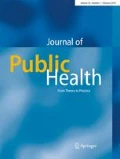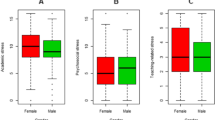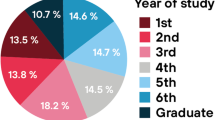Abstract
Background
The lack of motivation for learning is a common problem in the student population. The fear of exams is often followed by intense symptoms such as insomnia, diarrhea, lack of concentration, vomiting, nervousness, and crying. Undoubtedly, all these factors cause specific student exposure to the risks of mental health disorders.
Aim
The aim of this study was to investigate the intensity of stress factors and their influence on medical students.
Methods
The study was prospective and conducted on a sample of 858 students in their 2nd to 5th years of study at the Medical Faculty of Nis University (68% females, 32% males). All students were investigated by specially designed authorized questionnaires to determine the stress levels.
Results
A total of 67% of the students report constant exposure to stress situations. The factors found to have a significant association with stress development were corruption and the social situation, lack of money, pressure prior to exams, relationships of the respondents with their immediate family and partners, as well as the illness of a close person (p < 0.01).
Conclusion
The number of students with problems of mental health is increasing. Stress levels as well as the severity of the students’ problems are constantly rising. Therefore, preparing students for their academic pursuits today should not just be based on a scientific approach and the learning process, but also should establish support and mentorship in order to identify stress factors early on and treat them properly.
Similar content being viewed by others
Introduction
In the last 20 years, Serbian society has experienced turbulent events, including wars, economic sanctions, destruction of the previous system, loss of values, etc., which have substantially deteriorated the overall social situation and led to unsatisfactory economic conditions. However, in the last several years, Serbian society has been undergoing certain reforms that are especially dominant in the area of university education and health care.
The prevalence of mental disorders has increased by 13.5% from 1999 to 2002, so that they now represent the second largest public health problem after cardiovascular diseases (Lecic-Tosevski et al. 2007).
On the basis of the study “Health state, health needs, and use of health care services of the people of Serbia” conducted in 2000 on a sample of 11,742 adults, the following results were found:
According to self-evaluation, depressive symptoms were present in 44% of the total population (20% of the examinees had very prominent depressive symptoms, 24% had insomnia, and 62% felt nervous). About 10% of the subjects responded that they felt intensive tension, and 40% of the subjects had emotional problems (Jovic 2002).
The student population compared to the elderly population and non-student population is exposed to specific stress factors that may seriously deteriorate mental, physical, and social health (Stewart-Brown et al. 2000; Dyrbye et al. 2006).
A very common problem of students is the lack of a maintainable study plan and motivation to study. These are the factors that shape specific students’ exposure to the risks of mental health disturbance (Williams et al. 1995; Taras 2005).
One of the aims of the global strategy of the World Health Organization for the European Region by 2020 (“Health for all”) is the health of the young (aim 4) and improvement of mental health (aim 6) (WHO 1998b).
Aim 6.1 states that the "prevalence and adverse effects of mental health problems should be reduced and people’s ability to cope with stress events in life should be increased" (WHO 1998b).
According to this strategy, public health workers should increase their research and broaden their activities in order to reach the raised standards.
Aim
The aim of this study was to determine the prevalence of stress and to point out the main stress factors and the intensity of these factors among students of the Faculty of Medicine, University of Niš.
Materials and methods
The study is prospective and was performed on a sample of 858 students (583 males, 275 females) in their 2nd to 5th study year of the Faculty of Medicine, University of Niš, Serbia, in 2007. All students were given a specially made, authorized questionnaire by the authors with the aim of determining the stress level. They were asked to answer whether they were under stress and to point out the reasons that made them feel this way.
Students reported stressful situations they were exposed to, ranked them according to the intensity, and graded each stated situation from six to ten. The ten most frequently cited stress factors were singled out from the questionnaire and then statistically analyzed. All grades ≥8 referring to any of these factors were taken as the border criterion value for the presence of stress.
The students graded the stress levels from six to ten because they are used to these grades at their school and consider them to be their best known method of measurement. Grades ≥8 were taken as the border criteria, because similar grades were used by professors (grades <8 are not very good, but grades ≥8 mean that students have passed with very good scores).
Afterwards, the level of association between stress factors and present stress were investigated.
The significance was taken into account if the confidence interval was higher than 99% (p < 0.01), and the strength of significance was then measured by contingence coefficient (C).
The obtained data were analyzed by adequate statistical tests (t-test and χ2 test), and the results were presented in tables and graphs. Statistical analysis was performed by SPSS program 11.0 with the Windows XP system (SPSS Inc., Chicago, IL).
Results
The investigation included 858 students of the Faculty of Medicine, University of Niš. The student characteristiscs are presented in Table 1.
The total number of students included 583 female (68%) and 275 male (32%) students. The average age was 21.9 ± 2.0, whereby there was no statistically significant difference between male and female students.
The mean study year of the students was 2.5 ± 1.3 years. T-test showed no significant difference between male and female students (Table 1).
The comparison of stress situations along with students’ self-evaluation of the presence and intensity of stress showed that there were 575 students reporting the presence of constant exposure to some of the most frequently presented stress factors. One hundred fifty-five male students (56%) and 420 female students (72%) stated that they were under constant stress. It was found that the prevalence of stress was significantly higher in female students than in male students (χ2 = 20.78, df = 1, p < 0.01).
The most important stress factors included the problem of corruption (χ2 = 125.84, df = 1, p < 0.01) with contingence coefficient C = 0.36, as well as the lack of money (χ2 = 85.41, df = 1, p < 0.01) with C = 0.3.
The overall social situation (χ2 = 72.26, df = 1, p < 0.01) and exam pressure (χ2 = 37.01, df = 1, p < 0.01) had a similar contingence coefficient (C > 0.2) (Table 2).
Problems with a partner (χ2 = 30.20, df = 1, p < 0.01) and family disagreement (χ2 = 24.14, df = 1, p < 0.01) also showed statistical significance, but their intensity was slightly low (contingence coefficient was C < 0.2) (Table 2, Fig. 1).
Illness as a stress factor (χ2 = 7.98, df = 1, p < 0.01) showed low statistical significance in comparison to the aforementioned factors (contingence coefficient C < 0.1) (Table 2).
The factors that showed no significant correlation with stress occurrence were: death of a close person (χ2 = 37.01, df = 1, p > 0.01), quarrel with a friend (χ2 = 0.03, df = 1, p > 0.01), and being in a traffic jam (χ2 = 37.01, df = 1, p > 0.01) (Fig. 1).
Discussion
The number of female students in this study was significantly higher than the number of males. These data are in correlation with the data from the Department of Student Affairs of the Faculty of Medicine. This student structure is similar to other universities in Serbia.
The experience today greatly differs from that up to the 1980s. The number of students with mental health problems is increasing, leading to the elevation of stress levels as well as to the severity of problems. Similar results are reported by other authors as well (Maniam 1994; Tang et al. 2005; Cook 2007).
The fear of exams is very often accompanied by intense symptoms, such as insomnia, diarrhea, lack of concentration, vomiting, nervousness, and crying; sometimes, fear borders on panic (Melrose and Shapiro 1999).
The Faculty of Medicine represents one of the most popular choices for ambitious high school children. However, due to very strict entrance exams, only candidates with excellent grades in high school enroll in this faculty. In addition, the syllabus and regimen of study at the Medical Faculty are much more rigorous and stressful in comparison to some other faculties (Ko et al. 1999).
Female gender stood out as an independent risk factor for the occurence of stress. Other studies also show that female students report higher stress levels in comparison to males (Dyrbye et al. 2006; Kaya et al. 2007). Medical students had higher stress levels (females in a higher percentage than male students) compared to the total population. Similar reports are provided by other authors, too (Williams et al. 1995; Jablensky et al. 2000; Dahlin et al. 2005).
Medical students recognized that studying medicine contributes to stress, as experienced in their undergraduate careers (Chew-Graham et al. 2003). In this study, students reported that perceptions of stigma associated with mental illness, including stress, were prevalent in the student body and were perceived to continue throughout the medical profession. Avoidance of the appropriate behavior of seeking help starts early and is linked with perceived norms that dictate that experiencing a mental health problem may be viewed as a form of weakness, which has implications for subsequent successful career progression (Chew-Graham et al. 2003).
Since Serbian society has been in a vicious circle of transition in the last 20 years, it is understandable that such social situations contribute to the feeling of uneasiness among young students. In a system of disturbed values where students do not have a clear perspective, it is not surprising that corruption is the most prominent problem, i.e., the most important stress factor for students.
According to Roberts et al. (1999), the mental health of British students who were lacking money or in debt was significantly poorer than that of the equivalent general population. Our findings also indicate that lack of money is one of the most important stress factors for students.
On the other hand, the Serbian health-care system (Lecic-Tosevski et al. 2007) and higher educational system have not been completely reformed and are not in accordance with the needs of the population and world trends; this also makes these relations more complex.
Conclusion
Stress disorders are very common among medical students. In the process of preparing students for their future professions, much more is needed than sheer professional skills and necessary knowledge. Therefore, establishing support and mentorship is of great importance so that risk factors for stress disorders may be identified and treated at an early stage. Early detection shortens the duration of emotional disorder events and results in less social deterioration in the long run (Finlay-Jones and Burvill 1971; Firth-Cozens 1987; Jacobs 2001).
Since students first look for the support of their colleagues and teachers, it is very important to found mentor programs that can give students adequate consultations and help (Wolf et al. 1990). This mentor program should also provide consistent support, guidance, and concrete help to students in need of a positive role model or who may simply need to have another significant adult present in thier lives, especially if going through a difficult or challenging situation. The goal of student mentoring is to help students involved in the program to gain skills and confidence and be responsible for their own futures.
The prevalence of mental health disorders in medical students is significantly higher in those students who, aside from corruption, social situation, and lack of money, reported exam pressure, problems with a partner, and family disagreement.
Aim 4 of the WHO policy document states that by 2020, the young should be healthier and more able to fulfill their social roles (WHO 1998b). Aim 6 states that by 2020, psychosocial welfare should be improved by making all professional services more available to people with mental health disorders (WHO 1998b).
Therefore, recognizing these factors as stress at an early stage and applying an appropriate treatment of counseling, group work, or medical therapy are very important.
References
Chew-Graham CA, Rogers A, Yassin N (2003) ‘I wouldn’t want it on my CV or their records’: medical students’ experiences of help-seeking for mental health problems. Med Educ 37(10):873–880
Cook LJ (2007) Striving to help college students with mental health issues. J Psychosoc Nurs Ment Health Serv 45(4):40–44
Dahlin M, Joneborg N, Runeson B (2005) Medical student welfare stress and depression among medical students: a cross-sectional study. Med Educ 39(6):594
Dyrbye LN, Thomas MR, Shanafelt TD (2006) Systematic review of depression, anxiety, and other indicators of psychological distress among U.S. and Canadian medical students. Acad Med 81(4):354–373
Finlay-Jones RA, Burvill PW (1971) The prevalence of minor psychiatric morbidity in the community. Psychol Med 7:475–489
Firth-Cozens J (1987) Emotional distress in junior house officers. BMJ 295:533–536
Jablensky A et al (2000) Psychotic disorders in urban areas: an overview of the Study on Low Prevalence Disorders. Australia and New Zealand Journal of Psychiatry 34:221–236
Jacobs KS (2001) Community care for people with mental disorders in developing countries. Problems and possible solutions. Br J Psychiatry 178:296–298
Jovic S (2002) Mental health promotion in community: motivation procedure and communication skills. Paper presented at: Health in 21st century. Proceeding of the 1st Conference of Social Medicine of Serbia and Montenegro; September 4–7; Bukovicka Banja, Serbia
Kaya M, Genç M, Kaya B, Pehlivan E (2007) [Prevalence of depressive symptoms, ways of coping, and related factors among medical school and health services higher education students]. Turk Psikiyatri Derg 18(2):137–146
Ko SM, Kua EH, Fones CSL (1999) Stress and the undergraduates. Singapore Med J 40:627–630
Lecic-Tosevski D, Pejovic-Milovancevic M, Popovic-Deusic S (2007) Reform of mental health care in Serbia: ten steps plus one. World Psychiatry 6(2):115–117
Maniam T (1994) Psychiatry morbidity in an urban general practice. Med J Malaysia 49:242–246
Melrose S, Shapiro B (1999) Students’ perceptions of their psychiatric mental health clinical nursing experience: a personal construct theory exploration. J Adv Nurs 30(6):1451
Roberts R, Golding J, Towell T, Weinreb I (1999) The effects of economic circumstances on British students’ mental and physical health. J Am Coll Health 48(3):103–109
Stewart-Brown S, Evans J, Patterson J, Petersen S, Doll H, Balding J, Regis D (2000) The health of students in institutes of higher education: an important and neglected public health problem? J Public Health Med 22(4):492–499
Tang GZ, Guo LT, Huang XZ (2005) [An epidemiological study on mental problems in adolescents in Chengdu, China]. Zhonghua Liu Xing Bing Xue Za Zhi 26(11):878–881
Taras H (2005) Physical Activity and Student Performance at School. J Sch Health 75(6):214–218
Williams JBW, Spitzer RL, Linzer M et al (1995) Gender differencies in depression in primary care. Am J Obstet Gynekol 173:654–659
Wolf TM, Faucett JM, Randall HM (1990) A health promotion program for medical students: Louisiana State University Medical Centre. Am J Health Promot 4:193–202
World Health Organization (WHO) (1998b) Health 21: The HFA Policy for the WHO European Region: 21 Targets for the 21st Century. WHO Regional Office for Europe, Copenhagen
Conflict of interest
The authors disclose any relevant associations that might pose a conflict of interest.
Author information
Authors and Affiliations
Corresponding author
Rights and permissions
About this article
Cite this article
Visnjic, A.M., Milosavljevic, N.D. & Djordjevic, G.D. Stress factors of medical students in Serbia. J Public Health 17, 309–313 (2009). https://doi.org/10.1007/s10389-009-0250-0
Received:
Accepted:
Published:
Issue Date:
DOI: https://doi.org/10.1007/s10389-009-0250-0





